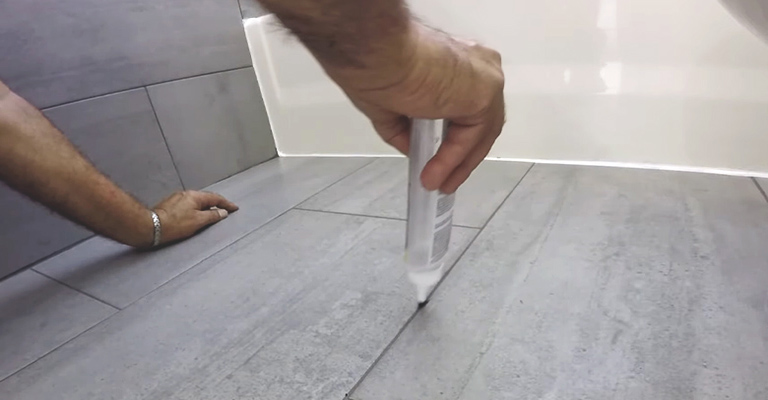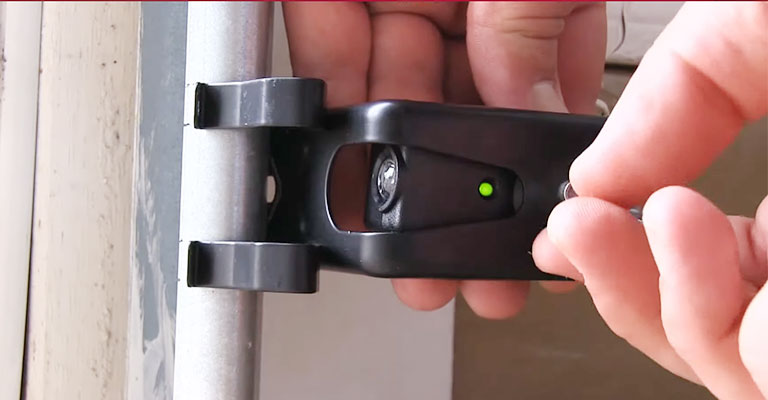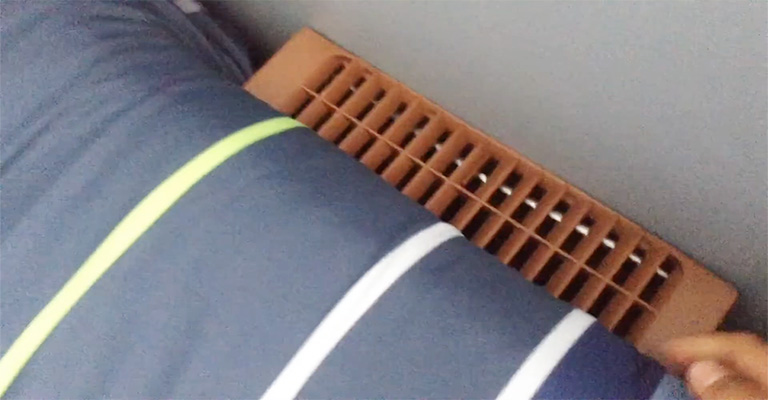How to Run Cable From Basement to Second Floor?
After checking the building code, plan out the cable route. Turn off the power and drill holes into the ceilings of the first and the second floor. Make use of fish tapes and use mounts to clip the cable to the wall. Pull the cable through the wall plate and connect it to the appliances.
How to Run Cable from Basement to Second Floor?
Running cables from the basement to the second floor involves certain steps. Whichever floor it is, the processes remain the same. They are explained below.
Step 1: Check the Building Code
Every cable might not be safe according to the safety standards of some locations. While they will allow you to install low voltage wirings like speaker wire, phone line, and network cable, double-check the building code for certain cables.
Step 2: Gather the Tools and Do the Measurements
To install a cable from the basement to the second floor, you will need a couple of tools. They include a 3/4 inch drill bit, cable mount, cables, measuring tape, cordless drill, hammer, etc.
Select the right cables that have a higher fire retardant rating and suitable for your walls. Measure the distance of the appliances that will make use of the cables. The cable will have to run between floors and along the baseboards and walls.
Therefore, you will have to take these calculations into consideration as well. The best practice is to always run more cable length than needed. This will allow more room to adjust later on.
Step 3: Determine the Access Point and Turn Off All the Power Sources
Spot an access point in the middle of the second floor. The cable will pass through from the top floor into the basement. The best way is to select a spot near the wall of the basement.
You should avoid places where there are wirings. Next up, turn off all of the power sources to steer clear of any kind of harm from the live wirings.
Step 4: Drilling
Take the cordless drill as the power of your home is cut off. Fit a 3/4 drill bit in the drill machine and start drilling while holding the machine at an angle of 90° to the floor. After drilling through the sub-floor and flooring, pull out the drill machine.
Extract the 3/4 inch drill bit and fit a 12-16 inch extension to the drill machine. Then refit the 3/4 inch drill bit into the drill machine. Start drilling into the same hole again while keeping the same drill angle. Stop your drilling when the drill passes through the ceiling of the lower room.
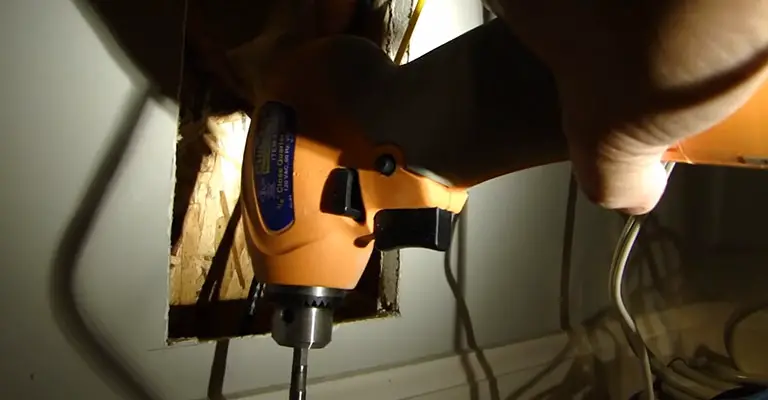
Step 5: Installation
The next step is to install the cables. Start from the upper levels and make use of the cable mounts. Then, run the wires along the baseboards. A cable mount will hold the cable in place with its clip.
Moreover, its in-built nail will fix the mount itself to the surface of the baseboard. Place the mounts in every four feet. Now, set the cables into the mounts and set them into the wall. You have to continue with it until you have reached the opening of each of the floors.
Step 6: Complete the Connections
Next up, pass the riser through the hole. Straighten out the hanger and tape the cable along the length of the hanger. Next, you have to slide the cable and hanger through the hole that was made in the first and second-floor ceilings.
Keep pulling the cable from the hole by moving down to the lower level. You will have to face no tangling issue as you are running cables along the walls. Mount the cables to the walls of your basement.
Similar to before, make use of mounts to attach the cables to the walls and down to the baseboards. Make sure you put the mounts 4 feet apart. Now connect the cable to the pre-determined devices and then the power supply on.
Drill Hole From Basement Ceiling to Floor Above
To drill a hole from the basement ceiling to the floor above, you will need a cordless drill machine, a 3/4 inch drill bit, and an extension. As the power will be cut off, a cordless drill bit is what you will use.
Fit the 3/4 inch bit into the drill machine and hold it in a way so that the drill bit is perpendicular to the drilling surface. Drill your way into the sub-floor and flooring.
Then stop the drill machine and take out the bit. Add the extension and put the drill bit back into the drill machine. Start drilling again in the same way and stop when you have passed through the ceiling.
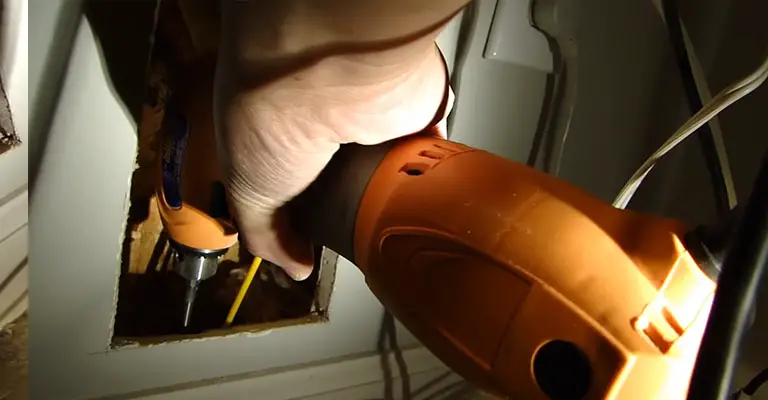
Running Cable Wires Through Finished Walls
To run cable wires through finished walls, you have to maintain some specific steps. Firstly, plan your route as you will have to keep several factors in mind such as Looping, drill holes, existing wires, vertical or horizontal placement, etc.
Next up, you will have to cut the box openings along the outline by using a drywall saw. Then, you have to drill holes into the wall plate to fish the cable down into the basement. Inserting a long wire into the drill hole will help you locate it when you enter the attic or crawlspace.
Thread the fish tape and then attach the cable to the fish tape. Next, you have to pull steadily on the fish tape while a helper feeds the cable. Grab the free end of the cable and attach the wires to the fish tape. Then, pull the cable through the wall plate. That is how you will get it done.
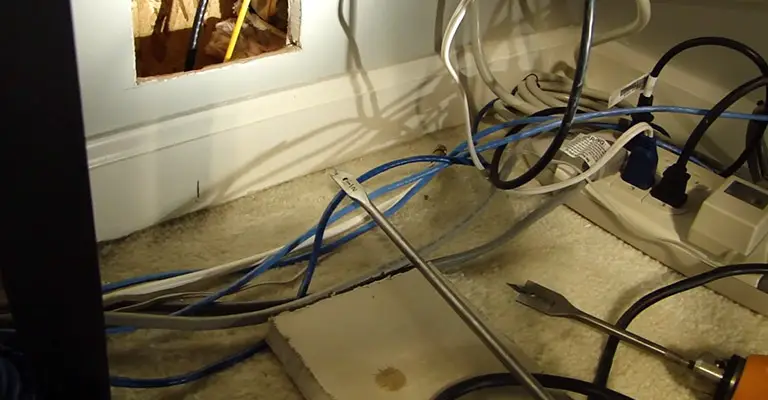
Run Electrical Wire Between Floors
The first step to run electrical wire between floors is planning. Check the building codes for the eligibility of the cables. Start by choosing the best location for setting up the wires.
Then turn off the power and drill a small pilot hole at the location of the outlet. Observe the situation and enlarge the hole. The next step is to attach the wire to a fish tape.
Feed it into the drilled hole until it reaches the opening on the other side. Run the wire to the desired destination and feed it through the back of the outlet box. Lastly, strip the wires and connect them to the device.
Frequently Asked Questions
Q: How big can I drill in a floor joist?
Ans: The hole must not be larger than one-third of the depth of the joist. The drill can be anywhere along the length of the joist.
Conclusion
Running cables from the basement to floors above takes some systematic steps to follow. The procedures involve risk and should involve experienced electricians or someone who has basic knowledge regarding them. This means inexperienced homeowners by no means, should handle it by themselves.
Running an ethernet cable or other types of electrical wires from your basement to the second floor is a task that may seem daunting at first, but with careful planning and attention to detail, it can be a rewarding home project. The keys to successful cable installation lie in the proper selection of materials such as plenum-rated cable for areas with air circulation, the strategic use of both interior and exterior walls to run wire, and skillful handling of tools to fish cable through walls and outlet boxes.
The process of wire routing requires a combination of traditional electrical work and modern computer networking knowledge, making it a versatile and useful skill for today’s tech-savvy homeowner. Whether you’re looking to create a wired internet connection in an upstairs room or are running new electrical lines, the steps discussed in this article will empower you to accomplish the task safely and efficiently.
Ultimately, running cable from the basement to the second floor is more than just a technical task. It’s a home improvement project that can significantly enhance your connectivity and convenience. With the right approach and patience, you can turn what might seem like an overwhelming task into an achievable one, thus stepping up your home’s functionality and digital readiness.
Also Read- 1/4 Inch vs 1/2 Inch Impact Driver


